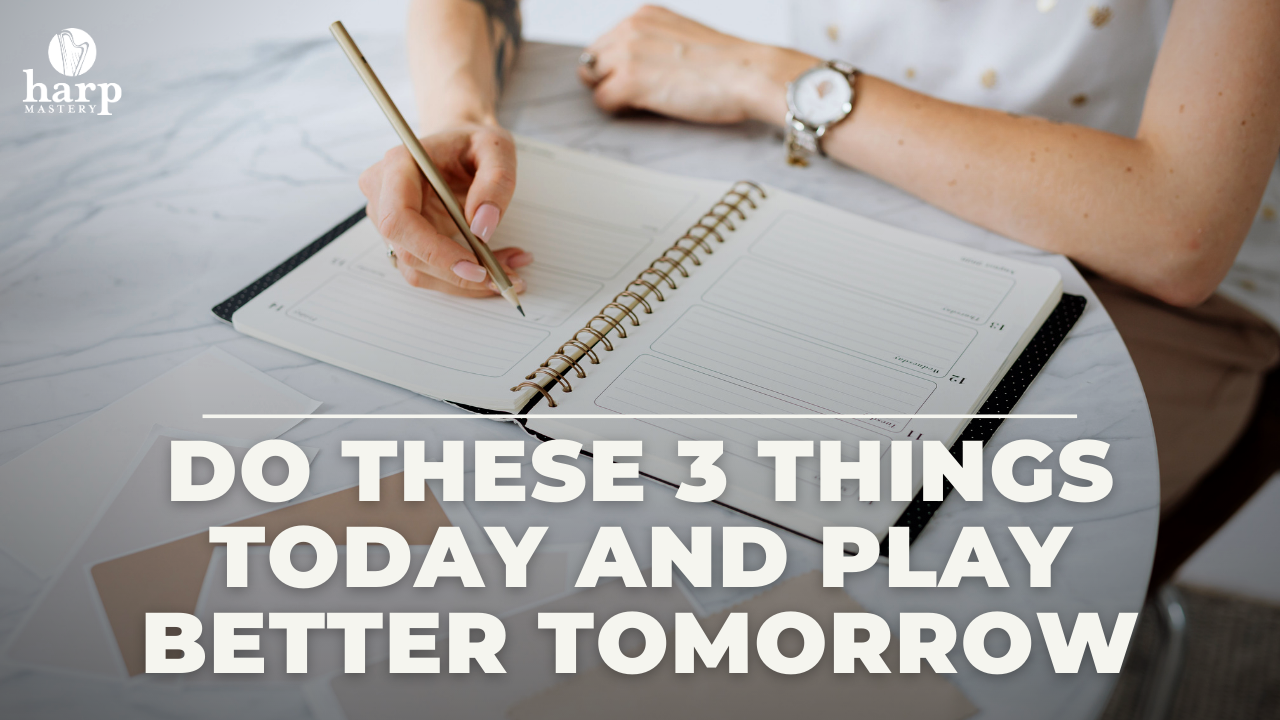Do These 3 Things Today and Play Better Tomorrow

I know I’m not the only one. Every harpist bumps into the brick wall now and again. It’s that place that you can’t seem to get beyond, when you are tantalizingly close to being able to play your piece but you can’t seem to get to the finish line. The practice that worked up to this point just won’t take you any further.
You could put that piece away. You could keep struggling with it. Or you could try a little anti-practice. What is “anti-practice?”
I realize this might sound like heresy, but the fact is that sometimes practice, or at least our usual kind of practice, is counterproductive. So much of our practice time is dedicated to solving problems and correcting details that we tend to lose sight of the big picture. It’s similar to being deep in the forest where all we can see is the trees. We can’t play the music for all the notes.
In order to find our way back to the music, we must let go of the details and reacquaint ourselves with the entire piece. After all, the notes and the fingering don’t have meaning in themselves. It’s their contribution to the music that is important. We need to put down the magnifying glass and enjoy the panoramic view.
Anti-practice is about experiencing the panoramic view. It’s about playing the piece, not practicing it. It’s about making the music flow, even if it isn’t completely correct yet.
Anti-practice may feel uncomfortable at first. Naturally, we are much more accustomed to “fixing” things in our practice than we are to simply playing. The first time you try it you may feel like you’re not really doing worthwhile work, like you’re being lazy. I can assure you, though, that this is not only hard work, but it is critical work.
- Anti-practice gives you a musician’s-eye view of the piece, rather than a technician’s.
- Anti-practice allows you to understand and enjoy your music instead of struggling with it.
- Anti-practice is about learning to play the music, and isn’t that what we really want to do?
Don’t misunderstand the concept. Anti-practice isn’t a free pass to play wrong notes or forget about the fingering or a steady beat. It is remembering why the notes, fingering and beat matter. It is about using your practice time well, so that you aren’t spending time on details that will change when you actually play the piece. For instance, that measure that is so tricky to practice, may be much easier when played in context.
Below are three of my favorite anti-practice techniques. Try one of them today, or all three. Feel how they refocus your vision of the piece, or at least of your practice. Look for the bigger picture and let the music show you what is really necessary to “fix.” Most of all, enjoy the freedom of playing music you love, even if it isn’t exactly right yet.
Will these techniques work miracles? Of course not, unless you call it a miracle when you realize you’re closer to playing your piece than you thought you were!
Anti-Practice Technique 1: Music of the Mind: Read it until you can hear it.
Start by taking your music to a different room (not your harp room). Read the music and try to hear it in your mind. Try to hear not just the general idea, but every note on the page. Go over the piece until you can “hear” it in your mind with some level of detail. Don’t move your hands to mimic your playing. Then go back to your harp and play what you hear in your head. Don’t worry about notes you are missing. Just try to recreate your vision for the piece as closely as you are able.
Anti-Practice Technique 2: Personal Trainer: Let an expert set the pace.
Find a recording of your piece played by a master harpist, or a recording that is close to the way you want to play the piece. Using earbuds so you can hear the recording clearly, play along with the recording. Don’t worry about your mistakes. Your sole task is to keep up with the recording and match the musicality - the dynamics, the pacing, the expression.
Anti-Practice Technique 3: Repeat Performance: Develop some stamina.
Play the whole piece through 3 times without stopping. Don’t stop for mistakes and don’t stop in between repetitions. This will help you get out of the trees and see the forest. It will also help you develop the focus and stamina required to play the entire piece. You will likely discover that the piece is less daunting, less difficult or more fun to play than you thought.
50% Complete
Two Step
Lorem ipsum dolor sit amet, consectetur adipiscing elit, sed do eiusmod tempor incididunt ut labore et dolore magna aliqua.